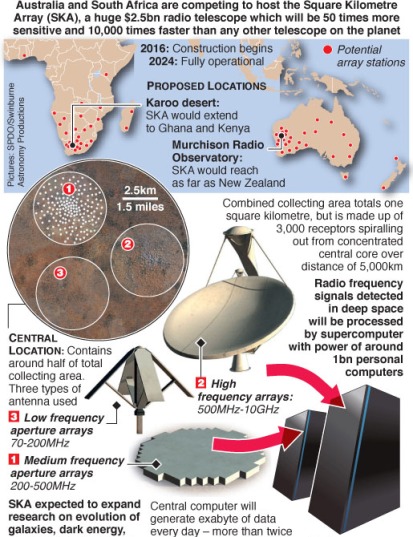Square Kilometre Array Project
A verdict on where to site the Square Kilometre Array (SKA) radio telescope will be taken soon. The choices under considerations are:
- South Africa
- Australia and New Zealand
The SKA will be built in the southern hemisphere, in South Africa or Australia and New Zealand, where the view of our own galaxy, the Milky Way, is best and radio interference least
What is “Square Kilometre Array Project”?
- It is a radio telescope project
- Approximate cost: $2 billion
- Will assist answer fundamental questions about the origin and evolution of the universe, and whether it contains life beyond our planet
- 50 times more sensitive than any other radio instrument
- Will be able to survey the sky more than 10,000 times quicker than any other existent telescope.
- SKA’s primary computer will have the processing power equivalent to 100 million PCs.
- SKA’s produced data will far go beyond current internet traffic and it will produce sufficient raw data to fill 15 million 64 GB iPods every day and would take nearly 2 million years to playback on an iPod.
- Will be fully operational by 2024.
- Project is under Britain-based consortium which includes Canada, China, Germany, Italy, the Netherlands, the United Kingdom as well as Australia and South Africa.
- The SKA is a global collaboration of 20 countries which is aimed to provide answers to fundamental questions about the origin and evolution of the Universe
- The project has its headquarters in Manchester, UK
Which are the parties to the Project SKA Organization?
As of May 2012 the members of the SKA Organization are:
- Australia: Department of Innovation, Industry, Science and Research
- Canada: National Research Council
- China: National Astronomical Observatories of the Chinese Academy of Sciences
- Italy: National Institute for Astrophysics
- New Zealand: Ministry of Economic Development
- South Africa: National Research Foundation
- The Netherlands: Netherlands Organisation for Scientific Research
- United Kingdom: Science and Technology Facilities Council
What are the challenges while choosing the site for SKA?
- Issue is in finding a site that has “radio quietness”.
- The major obstacles are Radio frequency interference (RFI) and physical characteristics including climate and subsurface temperatures.
- Other Challenges include: Connectivity across the vast extent of the telescope itself as well as to communications networks for worldwide distribution of data produced by the SKA.
- Apart from these problems, there is a clash b/w South Africa and Australia. South Africa has accused Australia of playing dirty tricks as Australia has raised security concerns of building such an expensive project in South Africa owing high rate of violent crime in South Africa.
What is Radio Quietness?
- Radio Quietness means the place should be free from Radio Frequency Interference (RFI).
What is Radio Frequency Interference (RFI)?
- RFI refers to man-made radio signals – including those signals created by radio and television stations that can surpass the signals astronomers are interested in detecting.
Working of SKA
The SKA will combine the signals received from thousands of small antennas spread over a distance of more than 3000 km to simulate a single giant radio telescope capable of enormously high sensitivity and angular resolution. The SKA will also have a very large Field-Of-View (FOV) with a goal at frequencies below 1 GHz of 200 square degrees and of more than 1 square degree (about 5 full Moons) at higher frequencies. One innovative development is the use of Focal Plane Arrays using phased-array technology to provide multiple FOVs. This will greatly increase the survey speed of the SKA and enable multiple users to observe different pieces of the sky simultaneously. The combination of a very large FOV with high sensitivity means that the SKA will transform the exploration of the Universe. With receiving stations extending out to distance of at least 3,000 km from a concentrated central core, it will continue radio astronomy’s tradition of providing the highest resolution images in all astronomy.

Source: Square Kilometre Array Consortium
Tags: Astronomy, Natural sciences